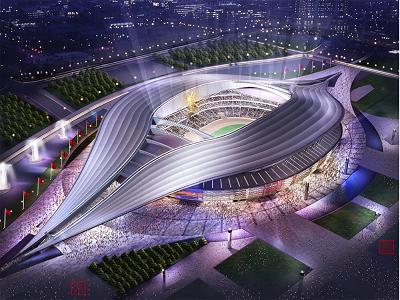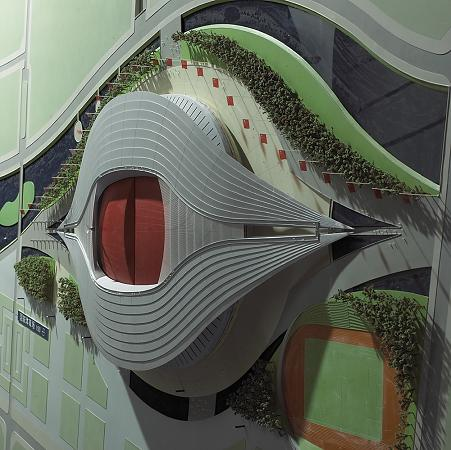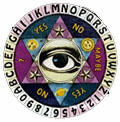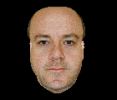China's All-Seeing Eye
By: Naomi Klein, Rolling Stone magazine
At: May 20, 2008
Downloaded from: Nicene Truth, a blog maintained by Jay Dyer
 [Pictured here is communist China's Olympic stadium, 2008.
Communist China and
Israel were two of the
first nations to adopt the DoD FERET-funded face
scan surveillance systems. As of this writing, in 2008, China is surveilled by the same
Iraeli mass surveillance systems as were installed in the telecom systems
of the United States and 100 other nations: "The Chinese government
implanted Narus (Israeli surveillance equipment)
in all its telecommunication organizations, including
China Telecom, China Netcom, China Mobile, and China Unicom. The services
included 'traffic analysis' and 'interception'." (James Bamford,
The Shadow Factory, page 258, DOUBLEDAY, Copyright 2008)
Narus is an Israeli company allegedly connected with the Israeli intel community.]
[Pictured here is communist China's Olympic stadium, 2008.
Communist China and
Israel were two of the
first nations to adopt the DoD FERET-funded face
scan surveillance systems. As of this writing, in 2008, China is surveilled by the same
Iraeli mass surveillance systems as were installed in the telecom systems
of the United States and 100 other nations: "The Chinese government
implanted Narus (Israeli surveillance equipment)
in all its telecommunication organizations, including
China Telecom, China Netcom, China Mobile, and China Unicom. The services
included 'traffic analysis' and 'interception'." (James Bamford,
The Shadow Factory, page 258, DOUBLEDAY, Copyright 2008)
Narus is an Israeli company allegedly connected with the Israeli intel community.]
Thirty years ago, the city of Shenzhen didn't exist. Back in
those days, it was a string of small fishing villages and
collectively run rice paddies, a place of rutted dirt roads
and traditional temples. That was before the Communist Party
chose it thanks to its location close to Hong Kong's port to
be Chinas first special economic zone, one of only four
areas where capitalism would be permitted on a trial basis.
The theory behind the experiment was that the China would
keep its socialist soul intact while profiting from the
private-sector jobs and industrial development created in
Shenzhen. The result was a city of pure commerce, undiluted
by history or rooted culture the crack cocaine of
capitalism. It was a force so addictive to investors that
the Shenzhen experiment quickly expanded, swallowing not
just the surrounding Pearl River Delta, which now houses
roughly 100,000 factories, but much of the rest of the
country as well. Today, Shenzhen is a city of 12.4 million
people, and there is a good chance that at least half of
everything you own was made here: iPods, laptops, sneakers,
flatscreen TVs, cellphones, jeans, maybe your desk chair,
possibly your car and almost certainly your printer.
Hundreds of luxury condominiums tower over the city; many
are more than 40 stories high, topped with three-story
penthouses. Newer neighborhoods like Keji Yuan are packed
with ostentatiously modern corporate campuses and decadent
shopping malls. Rem Koolhaas, Pradas favorite architect, is
building a stock exchange in Shenzhen that looks like it
floats a design intended, he says, to suggest and illustrate
the process of the market. A still-under-construction
superlight subway will soon connect it all at high speed;
every car has multiple TV screens broadcasting over a Wi-Fi
network. At night, the entire city lights up like a
pimped-out Hummer, with each five-star hotel and office
tower competing over who can put on the best light show.
Many of the big American players have set up shop in
Shenzhen, but they look singularly unimpressive next to
their Chinese competitors. The research complex for Chinas
telecom giant Huawei, for instance, is so large that it has
its own highway exit, while its workers ride home on their
own bus line. Pressed up against Shenzhens disco shopping
centers, Wal-Mart superstores of which there are nine in the
city look like dreary corner stores. (China almost seems to
be mocking us: You call that a superstore? McDonalds and KFC
appear every few blocks, but they seem almost retro next to
the Real Kung Fu fast-food chain, whose mascot is a stylized
Bruce Lee.
American commentators like CNNs Jack Cafferty dismiss the
Chinese as the same bunch of goons and thugs theyve been for
the last 50 years. But nobody told the people of Shenzhen,
who are busily putting on a 24-hour-a-day show called
America a pirated version of the original, only with
flashier design, higher profits and less complaining. This
has not happened by accident. China today, epitomized by
Shenzhens transition from mud to megacity in 30 years,
represents a new way to organize society. Sometimes called
market Stalinism, it is a potent hybrid of the most powerful
political tools of authoritarian communism central planning,
merciless repression, constant surveillance harnessed to
advance the goals of global capitalism.
Now, as China prepares to showcase its economic advances
during the upcoming Olympics in Beijing, Shenzhen is once
again serving as a laboratory, a testing ground for the next
phase of this vast social experiment. Over the past two
years, some 200,000 surveillance cameras have been installed
throughout the city. Many are in public spaces, disguised as
lampposts. The closed-circuit TV cameras will soon be
connected to a single, nationwide network, an all-seeing
system that will be capable of tracking and identifying
anyone who comes within its range a project driven in part
by U.S. technology and investment. Over the next three
years, Chinese security executives predict they will install
as many as 2 million CCTVs in Shenzhen, which would make it
the most watched city in the world. (Security-crazy London
boasts only half a million surveillance cameras.)
The security cameras are just one part of a much broader
high-tech surveillance and censorship program known in China
as Golden Shield. The end goal is to use the latest
people-tracking technology thoughtfully supplied by American
giants like IBM, Honeywell and General Electric to create an
airtight consumer cocoon: a place where Visa cards, Adidas
sneakers, China Mobile cellphones, McDonalds Happy Meals,
Tsingtao beer and UPS delivery (to name just a few of the
official sponsors of the Beijing Olympics) can be enjoyed
under the unblinking eye of the state, without the threat of
democracy breaking out. With political unrest on the rise
across China, the government hopes to use the surveillance
shield to identify and counteract dissent before it explodes
into a mass movement like the one that grabbed the worlds
attention at Tiananmen Square.
Remember how weve always been told that free markets and
free people go hand in hand? That was a lie. It turns out
that the most efficient delivery system for capitalism is
actually a communist-style police state, fortressed with
American homeland security technologies, pumped up with war
on terror rhetoric. And the global corporations currently
earning superprofits from this social experiment are
unlikely to be content if the lucrative new market remains
confined to cities such as Shenzhen. Like everything else
assembled in China with American parts, Police State 2.0 is
ready for export to a neighborhood near you.
Zhang Yi points to an empty bracket on the dashboard of his
black Honda. It used to hold my GPS, but I leave it at home
now, he says. Its the crime they are too easy to steal. He
quickly adds, Since the surveillance cameras came in, we
have seen a very dramatic decrease in crime in Shenzhen.
After driving for an hour past hundreds of factory gates and
industrial parks, we pull up to a salmon-color building that
Zhang partly owns. This is the headquarters of FSAN: CCTV
System. Zhang, a prototypical Shenzhen yuppie in a
royal-blue button-down shirt and black-rimmed glasses,
apologizes for the mess. Inside, every inch of space is
lined with cardboard boxes filled with electronics parts and
finished products.
Zhang opened the factory two and a half years ago, and his
investment has already paid off tenfold. That kind of growth
isnt unusual in the field he has chosen: Zhangs factory
makes digital surveillance cameras, turning out 400,000 a
year. Half of the cameras are shipped overseas, destined to
peer from building ledges in London, Manhattan and Dubai as
part of the global boom in homeland security. The other half
stays in China, many right here in Shenzhen and in
neighboring Guangzhou, another megacity of 12 million
people. Chinas market for surveillance cameras enjoyed
revenues of $4.1 billion last year, a jump of 24 percent
from 2006.
Zhang escorts me to the assembly line, where rows of young
workers, most of them women, are bent over semiconductors,
circuit boards, tiny cables and bulbs. At the end of each
line is quality control, which consists of plugging the
camera into a monitor and making sure that it records. We
enter a showroom where Zhang and his colleagues meet with
clients. The walls are lined with dozens of camera models:
domes of all sizes, specializing in day and night, wet and
dry, camouflaged to look like lights, camouflaged to look
like smoke detectors, explosion-proof, the size of a soccer
ball, the size of a ring box.
The workers at FSAN dont just make surveillance cameras;
they are constantly watched by them. While they work, the
silent eyes of rotating lenses capture their every move.
When they leave work and board buses, they are filmed again.
When they walk to their dormitories, the streets are lined
with what look like newly installed streetlamps, their white
poles curving toward the sidewalk with black domes at the
ends. Inside the domes are high-resolution cameras, the same
kind the workers produce at FSAN. Some blocks have three or
four, one every few yards. One Shenzhen-based company, China
Security &Surveillance Technology, has developed software to
enable the cameras to alert police when an unusual number of
people begin to gather at any given location.
In 2006, the Chinese government mandated that all Internet
cafes (as well as restaurants and other entertainment
venues) install video cameras with direct feeds to their
local police stations. Part of a wider surveillance project
known as Safe Cities, the effort now encompasses 660
municipalities in China. It is the most ambitious new
government program in the Pearl River Delta, and supplying
it is one of the fastest-growing new markets in Shenzhen.
But the cameras that Zhang manufactures are only part of the
massive experiment in population control that is under way
here. The big picture, Zhang tells me in his office at the
factory, is integration. That means linking cameras with
other forms of surveillance: the Internet, phones,
facial-recognition software and GPS monitoring.
This is how this Golden Shield will work: Chinese citizens
will be watched around the clock through networked CCTV
cameras and remote monitoring of computers. They will be
listened to on their phone calls, monitored by digital
voice-recognition technologies. Their Internet access will
be aggressively limited through the countrys notorious
system of online controls known as the Great Firewall. Their
movements will be tracked through national ID cards with
scannable computer chips and photos that are instantly
uploaded to police databases and linked to their holders
personal data. This is the most important element of all:
linking all these tools together in a massive, searchable
database of names, photos, residency information, work
history and biometric data. When Golden Shield is finished,
there will be a photo in those databases for every person in
China: 1.3 billion faces.
 Above, the Olympic stadium in Beijing, China, is designed
to form an eye.
Above, the Olympic stadium in Beijing, China, is designed
to form an eye.
"Does the Brotherhood exist?" "That Winston, you will never
know. If we choose to set you free when we have finished
with you, and if you live to be ninety years old, still you
will never learn whether the answer to that question is yes
or no. As long as you live, it will be a riddle in your
mind." -- 1984 by George Orwell


[Visit talmudunmasked.com for more information.]
| TROLLCAM | DATABASE | DOWNLINK | FACESCAN | WORLDCAM |
|
 Is Israel "the eavesdropping
capital of the world"?
Is Israel "the eavesdropping
capital of the world"?
|

|
 China's All-Seeing Eye, Rolling Stone magazine, May 20, 2008 China's All-Seeing Eye, Rolling Stone magazine, May 20, 2008 |
 Interpol Details Plans For Global Biometric Facial Scan
Database Every traveler to be scanned and checked against
terrorist faces, Oct 20, 2008, infowars.com
Interpol Details Plans For Global Biometric Facial Scan
Database Every traveler to be scanned and checked against
terrorist faces, Oct 20, 2008, infowars.com
|
 "Thus, virtually the entire American telecommunications system
is bugged by two Israeli-formed companies with possible links to Israel's
eavesdropping agency--with no oversight by Congress." -- James Bamford,
The Shadow Factory, 2008, DOUBLEDAY, page
246
"Thus, virtually the entire American telecommunications system
is bugged by two Israeli-formed companies with possible links to Israel's
eavesdropping agency--with no oversight by Congress." -- James Bamford,
The Shadow Factory, 2008, DOUBLEDAY, page
246
|
 "Big Brother will be watching you, thanks to biometric face recognition software. The REAL ID Act provides for federally mandated use of biometric data embedded in state driver's licenses."
TNA, June 27, 2005
"Big Brother will be watching you, thanks to biometric face recognition software. The REAL ID Act provides for federally mandated use of biometric data embedded in state driver's licenses."
TNA, June 27, 2005
|
 "With the development of television, and the technical advance which made it possible to recieve and transmit simultaneously on the same instrument, private life came to an end. Every citizen, or at least every citizen worth watching, could be kept for twenty-four hours a day under the eyes of the police and the sound of official propaganda." George Orwell, 1984, 1948 "With the development of television, and the technical advance which made it possible to recieve and transmit simultaneously on the same instrument, private life came to an end. Every citizen, or at least every citizen worth watching, could be kept for twenty-four hours a day under the eyes of the police and the sound of official propaganda." George Orwell, 1984, 1948 |
 "...that no man might buy or sell, save that had the mark,
or the name of the beast, or the number of his name" (Revelation
13:17)"
"...that no man might buy or sell, save that had the mark,
or the name of the beast, or the number of his name" (Revelation
13:17)"
|
|
|
|